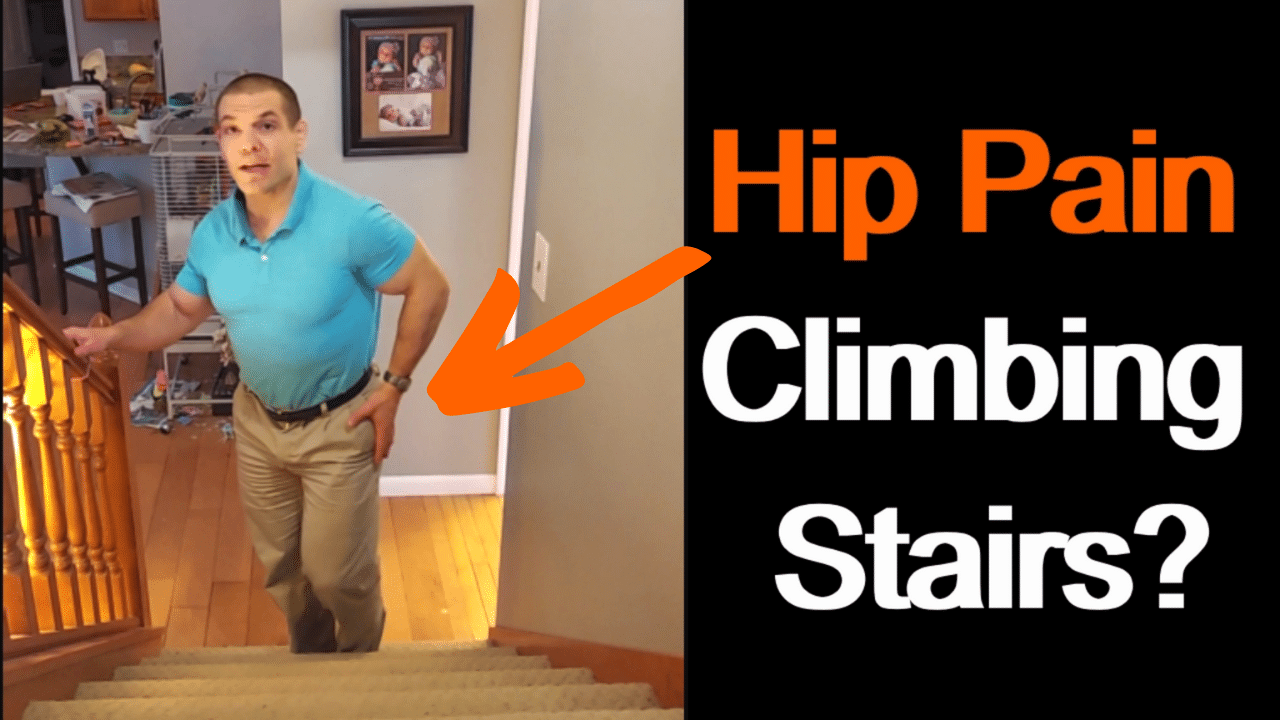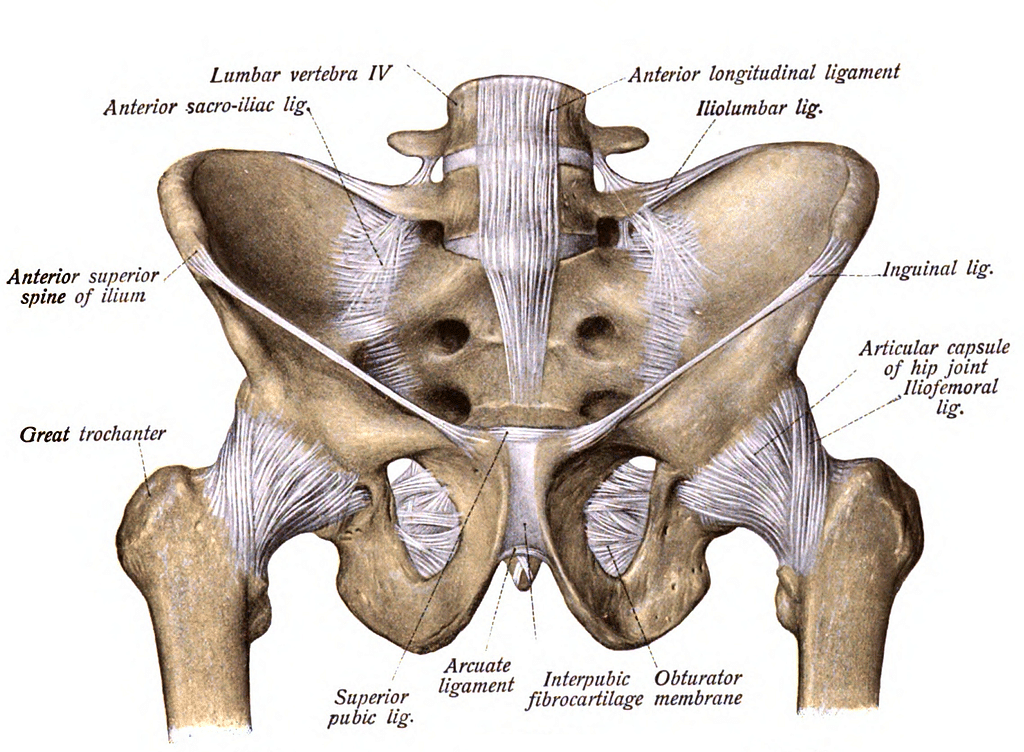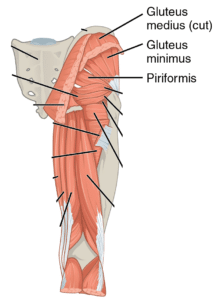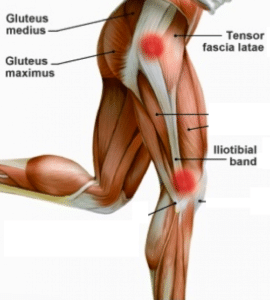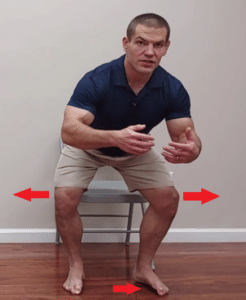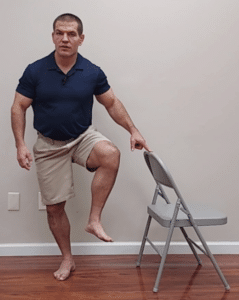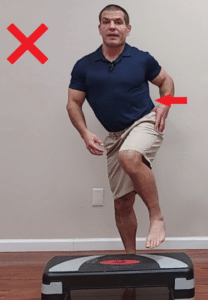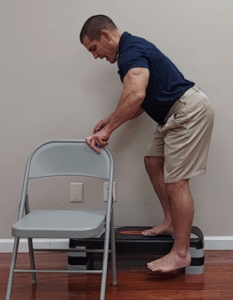Do You Get Hip Pain Climbing Stairs?
Watch the video to learn 6 easy tips to relieve pain in hip going up stairs.
Table of Contents
- What Causes Hip Pain Climbing Stairs?
- How Do You Relieve Hip Pain When Climbing Stairs?
- Compensations To Help Relieve Hip Pain Climbing Stairs
- Strengthening Exercises To Help Climb Stairs Without Hip Pain
- What Else Can Help Relieve Hip Pain Climbing Stairs?
- Need Help To Relieve Hip Pain Climbing Stairs?
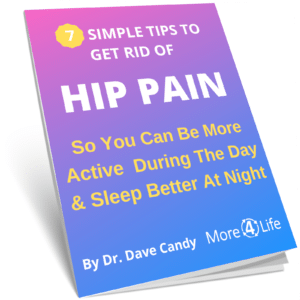
What Causes Hip Pain Climbing Stairs?
A lot of people who have hip pain climbing stairs think that they may have hip arthritis.
However, most people get pain on the outside of their hip when going up stairs, and hip arthritis pain is more often felt in the groin.
Many people think that their hip joint is the bump that you feel on the outside of your hip, but your hip joint is actually located in your groin. The bump on the outside of your hip is called the greater trochanter.
There are several structures that run over the outside of the greater trochanter that can cause hip pain climbing stairs:
- Your gluteus medius and your gluteus minimus tendons
- The trochanteric bursa
- Your IT band
So How Do You Know Which Structure Is Causing Your Hip Pain?
It truly doesn't matter that much which one of those structures it is, because the underlying mechanism that causes all of those issues is the same.
Weakness of your hip muscles is the underlying cause of pain in the hip when going up stairs
In particular, weakness of your gluteus medius and gluteus minimus muscles is often to to blame.
These muscles help balance your body weight over your leg. When they're weak, your pelvis drops down and the hip goes out to the side. That pushes the greater trochanter outwards and into the structures that cross over the outside of the hip that I mentioned above.
That can cause gluteal tendonitis, hip bursitis, or IT band syndrome when you're climbing stairs.
How Do You Relieve Hip Pain When Climbing Stairs?
Well, if the cause is weakness of the hip muscles, then the solution is to strengthen your gluteus medius and gluteus minimus muscles.
Clamshells are a common physical therapy exercises that people use to strengthen the gluteus medius, but it's not really a functional exercise.
You're laying down when doing it, and the load of just lifting your leg isn't anywhere near the effort of holding up the weight of your upper body.
So what's a better alternative?
One of the best ways to strengthen your gluteus medius and gluteus minimus is to stand on one leg and try to balance.
If you can't even STAND on one leg climbing stairs is going to be really difficult.
So it's a good idea to practice standing on one leg.
Get good at balancing on one leg, because it requires even more effort from your hip muscles when you start climbing stairs.
So if you can't balance one one leg and keep your pelvis level without letting your hip move out to the side, then balance is the first place to start.
The Most Important Tip When Climbing Stairs
The next step is to work on keeping your pelvis level as you're going up stairs.
As you push up the stairs, that requires more effort out of your hip muscles.
Which hip muscles?
You use your gluteus maximus (your butt muscle) to help you drive up the stairs.
Additionally you use your quadricep muscles to help push you up the stairs.
While you're doing those things, you use the gluteus medius and the gluteus minimus muscles to help keep your pelvis from drifting out to the side.
When you're going up and down stairs, if you put your foot up on the stair and then think about just pushing your knee outward, that activates your gluteus medius and your gluteus minimus.
They're hip abductor muscles which means they push the hip and knee out to the side.
If you focus on pushing your knee out to the side as you're climbing stairs it keeps your knee from drifting inwards that way and stretching your IT band and gluteal tendons over the greaer trochanter.
So, that's one easy tip to help you climb stairs more comfortably.
But what if you can't do that?
Compensations To Help Relieve Hip Pain Climbing Stairs
Using the handrail can relieve hip pain when going up stairs.
Most people do this intuitively.
That's smart just for the sake of safety and fall prevention anyway, especially if you have balance problems or hip weakness.
When you use a rail on the opposite side of the sore hip, it makes it a little bit easier to balance.
If you're standing on one leg, gravity is naturally going to tip you over away from the leg you're standing on.
So, if you have something to hold on to on that side, it helps counterbalance you and neutralize that force of gravity.
What if I only have one handrail on the same side as my sore hip?
That makes it a little harder to climb stairs, and you may even feel as if you need to pull yourself up the stairs using the rail.
If you only have a rail on the same side as the painful hip as you're going up stairs, then you might consider using a cane to help counter balance you.
This is particularly important if you have bad balance or have previously fallen.
Going Up One Stair At A Time
If you don't have a cane or don't want to use a cane, you can go up the stairs one step at a time for a short period of time going "up with the good" leg.
Ultimately though, most people want to get back to being able to go up the stairs step-over-step.
Strengthening Exercises To Help Climb Stairs Without Hip Pain
If you can't go up stairs without hip pain, and you've tried try pushing the knee out to the side and that's not even cutting it, you may need to do some strengthening exercises to help improve your hip's work capacity.
Try doing the 3-step hip strengthening exercise program in the video below.
It won't produce an immediate change in your hip pain, but over time, you'll get stronger and be able to climb stairs without hip pain.
Hip Strengthening Exercise 1
During the exercise, we’re going to work on strengthening the glute muscles as well as the arch muscles but doing it on 2 legs.
Before you can climb stairs with all of your weight on one leg, you need to be able to do the proper movement pattern on two legs first.
So to do that, we’re going to do a squat… but probably not a squat like you’re used to doing it.
Remember, we want to strengthen the foot muscles to support your arch, so we’re going to start from the ground up.
Stand in front of a chair just for safety sake when doing this.
Grip the ground with your toes so that it lifts your arch.
This will likely shift weight more to the outer side of your foot.
Now turn your knees out so that they’re aligned over top of the toes.
Slowly lower down keeping your knees turned out.
This strengthens your hip external rotators.
Once you’ve gotten as deep as you can comfortably using proper form, push through your heels and come back up to a standing position.
Try to do this as quickly as possible in order to generate the most power out of your gluteal muscles.
Power is measured in Watts which is defined as:
1 Watt = 1 kg*m2 / s3
Therefore, the faster move, the more power you generate.
So go down slowly with your knees turned out, and then explode up quickly, still keeping your knees turned out.
When you can get all the way down to the chair and back up 10 times in a row, you’re ready to move on to exercise 2.
Hip Strengthening Exercise 2
In this exercise, we start going into single leg strengthening.
Before you can climb a stair on one leg, you first have to be able to stand still on one leg.
You also have to be able to raise your leg in order to step up to the next step.
So for this exercise, you’re going to stand on one leg with your arch domed as before.
Hold on for balance as needed.
While doing this, lift the opposite knee up to waist level as if stepping up to the next step.
It’s very important that you be able to keep your pelvis level while doing this.
If you have to hike your hip up, to reach the next step, then by the time you’ve placed your foot on the step, you’re already in a position of hip adduction, which isn’t good.
So during this exercise, you’re actually working both legs. The stance leg works on foot and hip strength while the other leg work on hip mobility.
If you have trouble lifting your leg without hiking your pelvis, try turning your knee out slightly.
This allows more space in the hip joint and allows you to move your leg without compensation.
It also sets your leg up in a position of external rotation so that you’re in the correct position to push off.
You can really start to do exercises 1 and 2 at the same time, but don’t move on to exercise 3 until you have mastered the first two.
That’s because exercise 3 combines both exercise 1 and 2 together.
Hip Strengthening Exercise 3
For step 3, your going to start out with one leg up on a step or step stool.
You can do this on an actual step at your home, but it does make it easier if you have an adjustable height step as a lower step will be easier when first starting out.
JungleA 31" Exercise Step Platform For H...
40% OffStand sideways on the step and turn your knee outward and dome your arch.
Push through your heel to go up the stair.
Slowly lower back down just until the heel of your other foot touches the ground.
Then push up fast through your heel again.
Perform as many repetitions as you can comfortably on one leg and then switch to the other.
When you can do this you should now be able to climb stairs with your foot and hip in the proper position.
By doing this, you’ll probably have significantly less hip pain when climbing stairs.
What Else Can Help Relieve Hip Pain Climbing Stairs?
Getting physical therapy can help if you get pain in your hip when going up stairs.
There are several physical therapy treatments that work really well for hip pain.
Many people who pain in their hip going up stairs have a trigger point or a knot in their gluteus medius or gluteus minimus muscle (or sometimes their piriformis).
Doing treatments such as manual trigger point therapy or dry needling can sometimes give quick relief in as little as one session.
I can't promise that 100% of the time, but there are many times where dry needling can make a significant or improvement in a single session.
Need Help To Relieve Hip Pain Climbing Stairs?
If you'd like discover how to get rid of your hip pain so that you can climb stairs easier and with less discomfort, tap the button below to request a free discovery visit.
Like this post? See our other posts about hip pain
Such as:
Exercises for IT band hip pain

